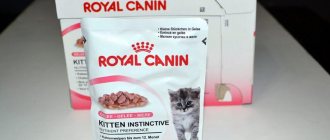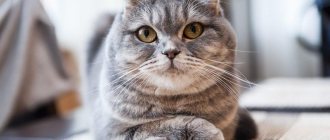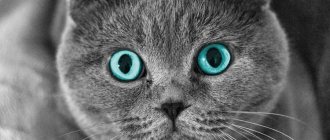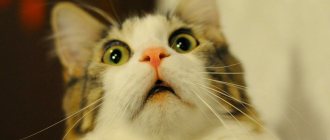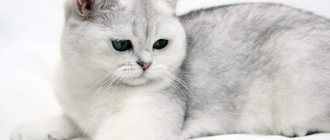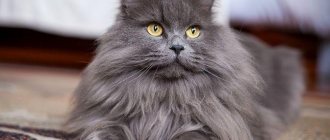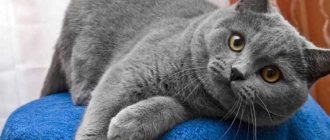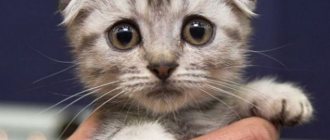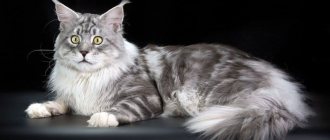Keeping a British Fold cat
Representatives of this unrecognized breed of the cat family are distinguished by their love of cleanliness and are ready to wash themselves or lick their fur all day.
British Fold cats are very clean animals.
British fold-eared cats demand the same reverent attitude towards their appearance from their owners.
Hygiene procedures
A fastidious British cat with drooping ears will be very happy if his plush fur is brushed at least twice a week. Dense, thick undercoat needs to be treated with a soft massage brush with rounded teeth.
British Fold cats need to be cared for in the same way as other purrs.
And water treatments should be limited to once every six months so as not to disturb the structure of the coat and not deprive the fur coat of “fullness.”
Caring for a British Fold cat also includes the following procedures:
- trimming nails once or twice a month (with the obligatory use of a scratching post);
- cleaning the ears twice a month (with a cotton swab dipped in a special solution);
- cleansing the eyes of dirt daily (with a cotton pad and drops);
- brushing your teeth daily (to prevent tartar - with a special brush and toothpaste);
- removing hairballs from the stomach every two weeks (with a special paste or cat grass).
If you accustom your pet to all cleaning activities from the first weeks of life, then maintaining hygiene will not cause discomfort to the purr in the future.
It is worth organizing a toilet for a British fold-eared pet away from drafts and noisy household appliances; it is even possible to use the owner’s bathroom. The tray can be anything - open with low sides, or closed. Since the animal is quite careful about the discharge of natural needs and at the same time loves solitude. It is advisable to use clumping options (wood and bentonite) as filler. The contents should be poured into the tray in a layer of 50–60 mm, then the furry’s paws will always be dry and clean. And the cat will be able to rummage around in the litter box to his heart’s content.
Feeding
When it comes to food, British Fold cats are not known for their gourmet tendencies. Which often causes excess weight gain.
British Fold cats easily gain extra pounds
Therefore, it is important to monitor the sequence of feedings and portion sizes. Despite the fact that you need to give food to the purr three or four times during the day, the gourmand should receive no more than 150–200 g of food at one time
British Fold cats are fed both premium ready-made food and natural food.
It is important to separate these types of food to maintain the health of your pet’s digestive system.
If the animal is determined to eat dishes made from natural products, then the owner should always add vitamins and minerals to the menu.
Here's what should be included in a cat's diet:
- lean fresh meat (beef, chicken);
- boiled meat and poultry (rabbit, turkey);
- boiled fish without bones and fins;
- hard-boiled chicken and quail eggs;
- boiled vegetables (carrots, zucchini, pumpkin);
- fresh vegetables and herbs (cabbage, cucumbers, parsley);
- cereals (oats, rice, millet);
- fermented milk products (cottage cheese, kefir).
But it is better to give fatty sour cream no more than twice a week in order to avoid stress on the liver.
It is imperative to provide your plush purr with round-the-clock access to clean drinking water.
It is forbidden to feed your British Fold cat spicy, salty or smoked food. Confectionery products, bread, fresh milk, as well as alcohol and spices will also spoil your pet’s stomach.
Purchasing a fold kitten
Although British Folds are for sale, do not forget that such a breed does not exist. By purchasing such a baby, you risk getting a mixed breed from a fold-eared cat. Of course, British Fold kittens will not have the necessary documents.
When choosing a pet, it is better to give preference to responsible breeders or nurseries who are concerned about the health of the offspring. In this case, prohibited mating options are excluded, and accordingly, kittens are born without genetic abnormalities.
When purchasing a Scottish Fold kitten, pay attention to the following factors:
- must not be less than 10 weeks old
- the kitten must have a veterinary passport with vaccinations
- It is recommended to inquire about the chronic diseases of parents
- At the age of 2 months, fold-eared kittens should be able to go to the litter box
- Fold ears drop on average on the 21st day of life, so it is not difficult to distinguish this breed when purchasing
The cost of a fold-eared kitten with documents starts from 5,000 rubles.
Origin story
Today it is impossible to find an exact answer to the question of where the modern British cat came from - there are at least two versions. The first of them says that cats, by that time already domestic and quite cute, were brought to the British Isles by the Romans two thousand years ago. At that time, the Roman Empire was already an advanced civilization, and the colonial administration insisted on bringing domesticated animals from the south, which effectively protected the granaries from mouse infestations.
The sailors did not intend to intentionally export the animals to the islands, they simply brought them with them for the same purpose - to protect the ship's provisions from unwanted eaters, but, apparently, such pets sometimes ran away at the port of destination.
Be that as it may, cats have been found on the territory of modern Great Britain for many centuries, however, for a long time they were not considered decorative. They moved into people’s houses relatively recently - before that, at best, they were kept in barns, that is, where they were most useful.
Only in the century before last, the British breeder Harrison Fair noticed that even street, stray individuals, despite all the ups and downs of life, still look pretty good
For many years this man selected the most beautiful and healthy kittens, until in 1871 the new breed entered the exhibition of decorative cats. The British immediately gained a certain popularity, and a few years later, uniform principles were developed for classifying the animal as this breed. During the Second World War, these cuties almost sank into oblivion, since the British had no time for their purposeful breeding.
Therefore, it was even decided to cross the remains with Persian cats for the sake of the survival of the breed. As a result, the modern Briton has changed somewhat in appearance, but has also acquired a useful calmness coupled with composure.
In our country, the first British cats appeared in the last century, but they began to reach the peak of popularity only in recent decades, and it is possible that the brilliant future of this breed is still ahead.
Breed standard
Color: All colors are accepted, including colorpoint without white.
Head: round, massive, wide, with a strong chin. The nose is short, wide and straight. The profile is curved (but without a stop). The cheeks are full and defined. Large, round whisker pads give the short muzzle a distinct outline. Stop in profile is a serious disadvantage
Coat: short, very thick, non-lying. Due to the thick undercoat, it stands away from the body like plush. The texture is dense to the touch.
Body: Medium to large sized cat. muscular, squat. The chest, shoulders and back are wide and massive. The limbs are short and muscular; the paws are thick and round. The tail is of medium length, thick, with a rounded tip. The neck is short and powerful.
Ears: The ears are medium in size, wide at the base, with slightly rounded tips, set wide apart.
Eyes: The eyes are large, round, and widely spaced. Eye color matches coat color.
British grooming
From childhood, kittens need to be taught hygiene procedures (grooming). Regularly examine the teeth, ears, eyes and care for the animal’s fur.
In the morning, a dark coating may appear in the corners of the eyes. It can be easily removed with a cloth dampened with water.
The fur enters the cat's stomach and settles inside in the form of lumps. In order to avoid blockage of the intestinal passages, from the age of 7 months the British dog must be accustomed to a special paste that helps dissolve the fur.
Grooming is simple:
- wash your pet no more than 2–4 times a year with a special shampoo, dry the coat with a hairdryer;
- Once a week, comb very carefully, without damaging the undercoat, remove dead hairs, it is best to use massage rubber brushes;
- during shedding, instead of combing, you should run a damp hand through the fur;
- The cat loves stroking against the growth of the fur.
Ears must be kept clean. If discharge appears, it is removed with a damp swab. The British have hairs growing on the tips of their ears; they are removed with scissors. The claws are inspected and trimmed once every two to three weeks. Every six months, worm prevention should be carried out with special preparations.
History of the origin of the breed
According to most employees of historical archives, archaeologists and researchers, the white British cat is one of the oldest breeds of domesticated cats.
According to legend, the British Shorthair cat appeared in the British Isles along with the army of conquerors from the Roman Empire. Artistic depictions of those years show animals whose distinctive features are gray coats and sharp fangs.
There is a second version of the appearance of cats in Great Britain. The animals were brought to the islands by French sailors, who used them to fight rats in the holds of ships.
Color of adult cats
British white cats are undoubtedly beautiful, but other shades look no less impressive.
Popular colors are:
- tortoiseshell;
- silver and golden shaded;
- patterned;
- plain and smoky;
- lilac;
- black.
These colors of British cats are truly fascinating.
Tortoiseshell tone
In this case, the coat should have an equal number of tones, and there should be spots on the face. Only cats are tortoiseshells. Beauties can boast a combination of shades such as chocolate/black/brown along with cream/red, as well as lilac/blue. Breeders rarely manage to obtain a tortoiseshell shade.
Silver and golden shaded
The main color can be seen on the back, head, tail and ears. As for the chest, belly, paws and collar, light gray predominates on these parts, which is similar to lilac.
Patterned or tabby
British tabbies can have a variety of body patterns such as leopard spots, distinctive stripes and large markings. At the base of the head, the fur may have a completely different shade - this is the norm. Pictured Britons are divided into many subspecies.
Plain and smoky
Monochromatic cats are those whose coat, including the undercoat, has the same tone. If there is at least one small inclusion, then the animal cannot be called monochromatic. Smoky beauties have a slightly lighter undercoat, due to which the color of their coat “plays” in the sun.
Lilac color
The fur of young kittens resembles a pink color, which transforms with age and becomes light purple. Only the undercoat differs in animals, which has a much lighter shade. As for the eyes of such kittens, they are copper or orange. It is very difficult to get a purple coat color - you need real luck.
Black color
Not only the coat and undercoat have a black (charcoal) tint, but also the skin. This color is rare, but only because kittens that are born charcoal may turn brown or chocolate as they age.
There are many rare colors that are rarely seen. So, there are Britons with dark markings, but the main color can be gray or brown. Many people like such “mixes,” but, unfortunately, “ordering” them is problematic.
Interesting facts about the breed
One of the unusual properties of the breed: animals fall into a stupor when, without their desire, they fall into the arms of a person. The owner must not forget about the inviolability of the pet’s noble body.
The most common problem for a mature animal is excess weight. Owners are advised not to overfeed their pets: this way they can avoid strain on the heart.
This breed has a good memory. In the list of interesting facts about the British, there is an opinion that the portrait of the Cheshire cat was copied from the breed of a pet in a plush fur coat.
Fluffy favorites are the great dormouse. Representatives of the British Shorthair cat sleep 15-16 hours a day.
The loud meowing of cats does not bother animal owners: the mustachioed, furry aristocrats are very restrained in showing emotions.
Anyone who wants to bring a handsome British dog into their home must understand the responsibility towards the pet. Care, restraint, education and love - this is what this unusual animal needs.
https://youtube.com/watch?v=KwssrS8o9So%3F
Advantages and disadvantages
Pedigree pure white kittens are bred by an officially recognized breeder, with membership in a cat club. The high price for a purebred kitten is justified by the purebred and exclusivity of the pet. These kittens have the following advantages:
- They have a certificate (passport) confirming all information about the breed:
- name of the breed,
- date of birth, kitten’s name, gender and color;
- the breed and nicknames of his parents; and
- information about the club and breeder.
- mark about the breeding class of the cat;
- purchase agreement
- Pre-familiar, predictable appearance and character of the animal.
- The British are well-bred, accustomed from an early age to the tray and scratching post.
- With proper care they are long-lived, up to 20 years
- Albinos are distinguished by their noble origin and prestige.
- Opportunity to participate in cat shows.
The disadvantages of snow-white British people include:
- Quite a price, determined by the breeding condition of the pet:
- show class for exhibitions;
- breed class for breeding;
- pet class for home, limited by the right of reproduction;
- Pets are excluded from the breeding class; white cats and female cats cannot be mated with each other.
- Snow-white kittens have genetic health problems: partial or complete deafness, decreased vision, loss of smell.
- Maintenance, care, food are expensive, especially for show class.
- The agreement provides:
- mandatory participation of a snow-white show-class pet in exhibitions;
- For the pet class, castration is recommended.
With all the advantages and disadvantages of the snow-white British, the main thing is to buy a healthy, sociable, affectionate pet. Surround your pet with care, attention, provide decent care and nutrition.
Source
Story
Today, there are several versions of pedigrees that explain where the British breed came from, but nevertheless, each version has its place. Many claim that the British cat breed was brought from France to other countries. According to legend, sailors took cats of this breed on trading ships to protect their products from rodents. Thus, representatives of the “British” ended up in various countries.
Interesting: in L. Carroll’s work “Alice in Wonderland” it was the blue British cat that served as the prototype of the Cheshire Cat.
Already in the 19th century, this breed attracted the attention of those breeders who were fond of exotic animals, because the blue British cat looks very elegant and beautiful. Harrison Ware made a special contribution to the development of this breed.
In 1871, Tabby was the first blue shorthair cat to win a prize at an exhibition. Already in 1950, this breed was approved in America, after which it became world famous.
Pitfalls of British hereditary diseases
The genetic mutation that gives this breed its adorable folded ears affects cartilage throughout their body and can also affect joints and bones.
Possible hereditary diseases of the fold cat:
- Shortened or excessively thick tail;
- Thickening of the fore and hind limbs, as well as their fused joints (congenital osteodystrophy);
- Ear mite problems and ear infections;
- Polycystic kidney disease;
- Hypertrophic cardiomyopathy.
Proper breeding of this charming breed has given Fold cats a new lease of life, and Scottish Folds are now an overall healthy and energetic breed.
Features of appearance. British cat breed
British cats have dense, short hair that provides reliable protection from cold and moisture. They are hardy and physically strong, and perform well in hunting. The main characteristics also include the good health of the animal. With proper care, the risks of developing chronic diseases are quite small.
External features include:
- powerful torso with a developed chest and massive muscles;
- strong limbs of short length that can withstand loads well;
- decent weight, varies between 4-6 kg on average;
- large round head;
- thick cheeks;
- strong, well-developed chin;
- The ears are medium-sized, erect, with a wide base;
- large, wide-set eyes;
- body proportions are harmonious;
- thick wool with a dense structure;
- The color of the coat is varied; this breed has about 60 variations.
Character traits
We suggest studying the character traits of this breed in order to understand how Scottish cats differ from British cats.
The British representative has an aristocratic character, so she is not prone to active games and does not particularly welcome “carrying” in her arms. A self-sufficient nature requires respect for itself; you need to be able to negotiate and reckon with it.
She has a very good memory, and if you offend a cat, she will remember this unpleasant gesture. A British woman can carry a grudge for a long time, but she will never show aggression towards loved ones. She will skillfully show her dissatisfaction through her behavioral manners.
Advantages of the British cat's character:
- a clean animal, quickly learns to use the tray and carefully looks after its fur;
- proud and self-possessed, lacks its owner with constant meowing in order to achieve what he wants;
- stubborn, principled;
- loves to sleep and lie on a soft sofa;
- a tendency towards idleness and an idle lifestyle;
- self-sufficient and independent;
- patient, can show aggression in the most rare cases.
A wayward cat should not be limited in its freedom; it loves to walk around the house without any restrictions. Another interesting feature of the British woman is her quick adaptation to her nickname. Thoroughbred individuals rarely respond to the “kiss-kit” that is familiar to all representatives of felines. You only need to call her by her first name!
External difference from Scottish
British and Scottish cats seem the same only at first glance, but if you look closely, you will notice the obvious characteristics of each breed. We have already written above about the manners and external characteristics of an aristocratic British woman.
https://youtube.com/watch?v=ekiFbTEGalc
In order not to make a mistake in your choice, we recommend focusing on the following signs of a thoroughbred Briton:
- the skull should have a round shape with regular contours;
- ears - only straight, low-slung and far away from each other;
- there is no pale rim around the pupil, as is true for Scottish representatives;
- necessarily a strong torso, large paws and a muscular body of large size.
In order not to make a mistake and buy a truly purebred British cat, choose an animal from experienced breeders with a good reputation.
Cost of kittens
Specialized nurseries have a fairly large selection of British dogs. The cost of a kitten depends on its color and class:
- Show. Elite kittens of this class are an example of the British breed. Their cost starts from 40 thousand rubles.
- Breed. Kittens of this class have subtle flaws. They are mainly bought as future breeders of offspring, since with the right pair they can easily produce top-class kittens. The price starts from 22 thousand rubles.
- Pet. The British of this class have significant shortcomings and do not meet the requirements of the breed standard, although they are very beautiful kittens. They are bought as pets and as an affectionate friend. Cost - from 6 thousand rubles.
In the range of 3 to 5 thousand rubles you can buy a pet without a pedigree.
All pets, and especially the British white, love their owners and especially need reciprocal feelings.
Differences between British and Scottish cats
Table of differences in appearance of two breeds according to world standards
| Body parts | British shorthair and longhair cat | Scottish fold and straight-eared cat |
| Head | Oval in shape, with a well-defined chin and strong jaw. Very reminiscent of an owl's head (this is one of the main differences between the Scots). | Round in shape, with strongly developed cheekbones and prominent cheeks. |
| Ears | Straight and short, with rounded ends. Wide set and slightly set to the sides. | The straight-eared Scotsman (Scottish Straight) has straight ears, narrower at the base, set wide and vertical. The Scottish Fold has ears folded approximately in half and hanging forward. They are distinguished by dense folds. |
| Eyes | Round, spaced far apart. The color depends on the coat color. | Round, widely set. The look of the Scots resembles that of a child, which is why breed lovers have given them the expression “babyface.” |
| Nose | Straight, with a slight depression at the forehead. | Small, but voluminous, has noticeable expansions at the base. |
| Torso | Squat, slightly elongated, stocky body with a wide and massive chest. | Compared to the British, it has more graceful body features - moderate length with rounded shapes. The chest is also well developed, but more level from the shoulders to the pelvis. |
| Paws | Short and powerful legs, thanks to which the animal appears larger, unlike its Scottish counterparts. | Medium length, slender and proportional to the whole body. |
| Tail | Short, thick and rounded at the tip. | It has medium thickness and length, more flexible and slightly pointed at the tip. You can distinguish a Scotsman by his tail with the naked eye. |
| Wool | It has a double structure, does not adhere to the body, and is quite elastic. Soft to the touch, like plush. | Also plush, very thick and dense. The difference is that it often depends on the color and time of year. |
How the British became related to the Scots
The Scottish Fold (Scottish Fold) received official status as a recognized breed in 1976. Breeding observations have shown that crossing two fold-eared cats results in offspring with a number of genetic problems. The kittens either had poor health and many abnormalities, or died.
The breeders decided to conduct an experiment and crossed the Scots with exotic, British and American cats.
As a result, kittens were born of two varieties: Scottish Folds (loose-eared cats) and Scottish Straights (cats with erect ears).
Today, crossing the Scottish Fold and the British cat is prohibited. Thus, the mating of two representatives of the Scottish Fold breed is also prohibited. This is an important fact for owners of these cats.
Crossing a female and a male lop ear leads to genetic diseases in the offspring. Therefore, it is correct to breed Scottish Folds with Scottish Straights (Scots with erect ears). As a result, healthy kittens are born, both lop-eared and with erect ears.
British cat health
Possible diseases
Experts classify the British cat breed as healthy individuals. It cannot be said that they never get sick. But there are no genetic diseases unique to the British. These animals are susceptible only to those ailments that affect all purebred animals.
Common heart problems include hypertrophic cardiomyopathy. It causes thickening of the wall of the ventricle, leading to disruption of the functioning of this organ, and if neglected, to death.
A blood clotting disorder is caused by hemophilia. This disease is dangerous due to large blood loss or internal bleeding. In representatives of the British breed, it can occur due to the crossing of closely related individuals. There is no treatment that completely eliminates hemophilia, so they are limited to blood transfusions and the use of iron supplements. Animals with this problem should not be part of the breeding process.
The British inherited the dangerous kidney disease polycystic disease from the Persian cat breed. It is characterized by the formation of tumors filled with fluid, which causes disruption of the urinary system. At the very beginning, the symptoms of the disease are not very noticeable, so they recognize it already at a fairly advanced stage. The only way to help your pet is by surgical removal of single cysts.
Otherwise, drug treatment is used, but it will simply relieve the animal’s pain and prolong its life by only a few months or a year.
Your pet's mouth can be affected by gingivitis, a disease that causes inflammation of the gums. If you don't start fighting it right away, it spreads to the ligaments, as well as the bones. As a result, teeth begin to fall out, and the infection spreads through the bloodstream throughout the cat’s body.
Overeating or abuse of treats from the host's table leads to the development of food allergies, as well as dermatitis.
Like all breeds, the British are recommended for comprehensive vaccinations, which are carried out under the supervision of a veterinarian on a schedule. The use of anthelmintic drugs will help get rid of intestinal parasites.
Reproductive health
Before getting a British cat, decide whether you need kittens in the future. If not necessary, then take care of sterilization or castration of the animal at a young age.
The optimal time for these procedures is 1 year of the pet’s life. Before this age, surgery should not be performed, because the reproductive organs of cats and kittens are not yet fully mature. Timely castration has a significant impact on the health of British cats and seals.
In the case of desired offspring, the female is considered ready for pregnancy at the age of one and a half years. Typically, gestation occurs without complications; as a result of childbirth, an average of 4-5 babies are born.
Consequences of mating a Briton and a Fold
The Scottish Straight breed was officially recognized in 2004. Since that time, mating of British and Scottish Folds has become prohibited.
Mating a British cat and a Fold is an interbreed type of mating that blurs the standards of both breeds. As a result of such reproduction, outbred kittens appear that do not fit any standard.
Failure to meet standards is not that important. The main reason for banning such breeding is the health problems of mixed-breed kittens.
The fact is that these two breeds have different bones; the British have a heavier bone than the Folds. Also, due to a special gene mutation, the Scots have a weak structure of cartilage. Heavy bones and weak cartilage are passed on to the offspring, and this leads to serious musculoskeletal disorders.
The consequences of crossing a Briton and a Fold lead to gross genetic disorders in the offspring. Therefore, such matings are prohibited!
Breed characteristics
British Longhair standard
The World Cat Federation has determined the breed standard:
- Body: Medium to large in size, muscular and stocky. The chest, neck, shoulders and back are massive and wide. Short and muscular paws of a rounded shape. The tail is short, with a rounded tip.
- Head: profile with stop.
- Weight: This breed weighs more than female cats. The cat's weight is 6.5 kg. The cat's weight is 4.5 kg.
- Eyes: Large and open shaped, wide-set eyes. The color directly depends on the color.
- Coat: long, smooth with a dense and dense undercoat. The undercoat is soft and protrudes from the skin. The presence of a “collar” on the neck and “pants” on the hind legs. The fur on the tail is thick and crumbly. The texture of the coat seems coarser than that of short-haired cats.
- Color: All coat colors are accepted.
- Lifespan: Can live 10-15 years. The age of a cat directly depends on its lifestyle, living conditions and diet.
Health
Nature has endowed the British Longhair cat with strong physical health. However, its increased immunity cannot fully provide protection against diseases:
Heart disease manifests itself in adults and is diagnosed by ultrasound. It is also carried out before the animal is sterilized - there is always a risk that the Briton will not tolerate anesthesia.
Owners of British Longhair cats should take care of their pets' coat. Its causeless loss (not to be confused with periodic molting twice a year) indicates the presence of diseases.
Cats of this breed are clean and love to wash themselves. Their long hair gets into the stomach in large quantities, which leads to serious gastrointestinal diseases. To facilitate hair removal and dissolution, pet stores sell specially developed preparations.
Vaccination of the British longhair cat is carried out according to the vaccination calendar. Young kittens are susceptible to various viral and infectious diseases, so breeders give kittens the following vaccinations against:
- ringworm;
- respiratory tract infections;
- rabies (we recommend the proven Nobivak);
- chlamydia;
- panleukopenia.
Vaccination calendar:
- The first vaccination is given to a kitten at 2-2.5 months.
- Revaccination is carried out 3 weeks after the first vaccination and with the same drug.
- A rabies vaccination is given at the same time as the second vaccination.
- The third vaccination is given upon reaching the age of 1 year.
- Subsequent vaccinations are given once a year.
With proper care, nutrition and following the recommendations, the British Longhair cat will not have any health problems. Once a year, for preventive purposes, you can show your pet to a veterinarian.
Personality of the British Longhair cat
The breed is increasingly winning the love of humans. She became so popular thanks to her flexible nature and unpretentiousness.
Kittens lead an active lifestyle, they are inquisitive and show interest in the world around them. It's easy to train babies to use the tray.
You can read about how to please your cat in this matter in our guide article on choosing cat litter.
Childhood activity is replaced by adult perseverance and equanimity. The British rarely get emotional and are difficult to scare. In moments of resentment, the pet hides in a secluded corner. A cat will definitely respond to physical pain with a bite or use its claws.
The British Longhair cat gets along well in families with children and easily gets used to a new place of residence. We can say that she is indifferent to children. If the owners need to leave the cat alone, it will not feel lonely - the British do not like excessive affection.
Cats sleep up to 20 hours a day. They love to play when they are awake. Cats have been shown to love knocking over various objects, so owners will have to put all fragile things away. Another passion of theirs is bags and boxes - the cat will gladly stick its curious nose even into the bags of guests.
The instincts of a predator make the British passionate hunters - they hunt anything that moves. An interesting fact is that obese Britons are better at hunting than slender representatives of the breed.
Health and vaccination
Fold-eared “Britons” are at risk for genetic pathologies. This is due to the fact that they are descendants of two closely related breeds, one of which carries the gene for lop ears. This gene not only makes the ears original, but can also cause serious pathologies of the skeleton and bone tissue.
IMPORTANT! In kittens born from two lop-eared individuals, osteochondrodysplasia is inevitable - an incurable deformation of the joints. Therefore, fold-eared pets are crossed only with straight-eared ones.
Fold-eared “British” dogs are also susceptible to:
- hearing loss;
- respiratory viral infections;
- claw fungus;
- helminthiasis;
- flea infestation;
- disruption of the heart;
- the appearance of renal cysts.
For preventive maintenance, your pet needs to be shown to a veterinarian annually and vaccinated. Each vaccine is administered according to the time limits established by the veterinarian. Vaccination helps protect your pet from panleukopenia, rabies, and respiratory infections.
A healthy and well-groomed British Fold cat lives about 15 years.
Health, reproduction, kittens
British Folds were created through crossbreeding, so they can be quite sickly.
In particular, they have a high risk of developing the following pathologies:
- Deformation of cartilage in some individuals affects not only the shape of the ears, but also the entire spine. Therefore, they may experience fusion of the vertebrae, shortening of bones and thickening of joints, and the appearance of bone growths, which can only be corrected surgically.
- Hypertrophic cardiomyopathy (HCM) is a genetically determined uneven thickening of the interventricular septum and ventricular walls. Progresses to heart failure with chest pain. The disease makes itself felt in individuals after a year and is detected by ultrasound.
- Obesity. Due to a good appetite, if you do not monitor your pet’s nutrition and activity, it can gain excess weight quite quickly. This in turn will lead to many health problems. A proper diet, outdoor games and plenty of space in the house or yard increases his activity and reduces the risk of illness.
- Worms, fleas and other parasites come from the outside, are absorbed with food or hairballs when licking, especially if the cat is in contact with other animals. Now there are many means to get rid of them, which are best used as prescribed by a veterinarian.
- Infectious diseases. These are immunodeficiency, aspergillosis with chronic runny nose, calcivirosis and rhinotracheitis. And especially life-threatening peritonitis, panleukopenia, leukemia, rabies, tuberculosis. To prevent them, vaccinations are necessary: annual against rabies starting from the age of 8 months, and others no later than the three-year period when maternal immunity is still in effect.
On average, adults live from 14 to 20 years if you monitor their condition.
For example, periodically lifting an animal by its front legs reduces the likelihood of developing spinal pathologies. Timely and proper care will avoid many other problems.
Particular attention should be paid to the issue of breeding pets. If owners want to get healthy offspring, under no circumstances should individuals with the same gene be crossed when both of them have drooping ears.
It is worth taking individuals with straight and curved ears, it is better if both of them belong to the British breed. And after 9 weeks it will be possible to get a mixed litter, but the likelihood of their mutation is significantly reduced.
We recommend reading: Sphynx Brush breed: character, habits, care and education of cats
The peculiarity of lop-eared cats is that they are all born with erect ears. They acquire their shape only on the 21st day, then it will be clear which of the babies will be straight-eared and which will be a typical representative of the British breed.
The owners will only have to choose suitable nicknames, remembering that the British are proud and independent animals, and they will serve their family faithfully.
Pitfalls - hereditary diseases of the British
Unfortunately, when buying a kitten, you may encounter the development of hereditary diseases. Experienced breeders monitor the manifestations of each disease, eliminate the defective gene in a timely manner, achieving healthy offspring, which cannot be said about amateurs who cross a cat with a similar cat.
Illiterate mating between a British and a Scot can lead to various diseases in the offspring, even if the mother and father are completely healthy. The most common problem is improper formation of the skeleton. As a rule, these are deformations of the spine and toe bones.
Growths may form on the bones of the paws, it becomes difficult for the animal to walk, and it becomes lame. Help consists of surgery and removal of bone growths. In some cases, heart disease develops, which usually appears after a year. To diagnose the disease at the initial stage, it is worth conducting an ultrasound of the heart annually.
If you are lucky enough to acquire a healthy kitten, most likely it will have a typical British disposition. He will be calm, balanced, love sleep and food. In childhood, the animal may be naughty, but in the future it becomes more and more lazy.
Who is better to choose
It is difficult to say which breed is better, British or Scottish. The choice of a pet is based on the preferences of the future owner, daily routine and rhythm of life. The British cat quickly becomes attached to the house and considers himself a full member of the family. He likes to be left alone for a long time, but a purebred animal needs proper care and timely education.
The British man’s appearance is brutal, his behavior is very important. It is no coincidence that previously only the rich segments of the population could afford to keep such cats.
The facial expressions of pets are interesting and funny. Up to a year old, babies are playful and active, but closer to the age of two, the cat’s habits change, she becomes calm and sleepy. The baby loves to sleep, lounging on the plush back.
The Scottish cat, as a kitten and as an adult, is playful and noisy. He will run around at night or run around the apartment with a rubber mouse.
The Scottish woman loves children, she likes the attention of the owner and family members. Everything in it is for a large and noisy company:
- A funny pose in which your pet often sits: on its tail, with its long legs outstretched.
- Or the famous gopher stand, when the baby stretches vertically on its hind legs, tucking its front legs.
- Ability to walk on a leash and follow various commands.
This cat combines the qualities of cats and dogs. Caring for a cat is not difficult. The Scottish favorite cannot stand heights: flying from the top shelves is not possible for the animal due to the structure of its limbs.
How to distinguish a British kitten from a Scottish one
The difference between British and Scottish cats is obvious. It makes no sense for nursery owners to deceive those who want to buy babies of a certain breed.
The smaller the kitten, the more difficult it is to distinguish a British cat from a Scottish pet. Characteristic signs appear as the baby grows older. Therefore, it is better to buy a baby at the age of 2-3 months.
By this time, the Scotchfold ears, straight from birth, will acquire the desired fold. The eye color will gradually begin to acquire a constant shade that matches the color of the animal's coat. A mandatory item when choosing a kitten is to check the baby's tail: for a fold-eared baby, it should be long and mobile. The British have a powerful, thick tail, much shorter than that of the Scot.
The main points of difference between kittens of the British and Scottish breeds, which people pay attention to when choosing babies:
| British kittens | Scottish kittens |
| Heavier paws, clubfoot when walking | Long light limbs |
| Chubby cheeks | Cheekbones are not very pronounced |
| Large baby | Small in size |
| Round head | Elongated skull shape |
Babies do not differ much in their habits: up to a year old, representatives of these breeds are active and respond to play with pleasure. The difference in behavior between the British and Scottish cats will be noticeable in later life.
To the touch, the Scottish have fur that is more fluffy and soft, gliding, while the British have dense and thick fur. An inexperienced buyer will not be able to independently determine what breed the cub belongs to. The difference in behavior between the British and Scottish cats will be noticeable in later life.
British white color standards
The main requirement of the breed standard for the white British color is its ideal purity and uniformity. The fur should be bright white, without any tints, spots or inclusions of a different color, and each hair should be uniform in color from root to tip, without signs of ticking or smoke. The nose and paw pads can only be pink. But the permissible eye color varies, and the category of the animal’s breed code depends on it:
- BRI W 61 - white with blue eyes;
- BRI W 62 - white with orange eyes;
- BRI W 63 - white with multi-colored eyes;
- BRI W 64 - white with green eyes.
The dominant gene W (White) is responsible for the white color of cats.
The letter W in the code means White, and in any category, brightness and saturation of eye color is welcomed, which looks especially impressive against the background of white fur. By the way, only white Britons can experience such a phenomenon as heterochromia (difference of eyes), when one eye of a cat is blue and the other, for example, orange.
Photo gallery: white British dogs
Blue-eyed white Britons, contrary to popular belief, are not always deaf
Heterochromia is characteristic only of white British cats.
The green-eyed white British is very rare. The yellow-eyed white British is the most common variant in the breed.


